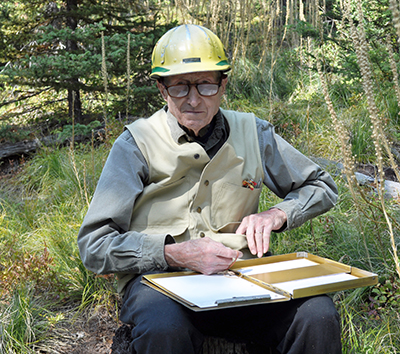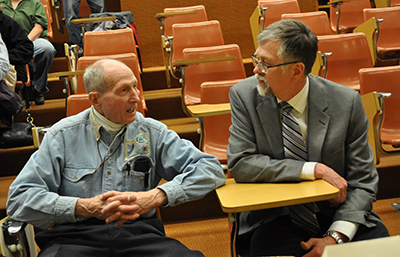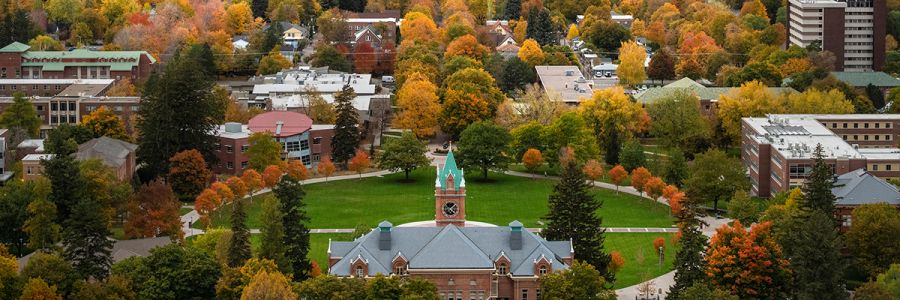Curator Emeritus Grows UM Herbarium through Philanthropy
May 30, 2023
For retired U.S. Forest Service ecologist and Curator Emeritus Peter Stickney, the University of Montana Herbarium is more than the state's largest collection of plant specimens; it’s a culmination of rich botanical and historical knowledge that serves communities worldwide.

For almost 60 years, Stickney has contributed thousands of plant specimens, time and expertise to the herbarium, a unit of UM’s Division of Biological Sciences in the College of Humanities and Sciences. He has also generously established an endowment to enhance the herbarium’s facilities, support a part-time curator who manages the collection and ensure this treasured resource continues to benefit future generations.
Stickney’s dedication began in 1957, when he moved from Oregon to Missoula to study range and wildlife habitats, including postfire forest succession, and started curating the U.S. Forest Service’s Missoula Research Center, or MRC. He curated the MRC herbarium for 50 years, and by 2010, he had contributed approximately 8,000 of its 15,500 specimens. Stickney was instrumental in transferring MRC’s collection to the current UM herbarium, single-handedly boxing specimens for its move to the Natural Sciences building on campus.
Now home to more than 90 cabinets containing nearly 150,000 specimens, some of which are over a century old, UM’s herbarium serves as the primary reference resource for botanists, ecologists, federal and private land managers, other experts in the region and the general public. It provides invaluable insights about the abundance of rare and endangered species, habitat relationships, the effects of climate change on plant species, curation of historical records and more.
Undergraduate and graduate students, the Montana Native Plant Society, the Nature Conservancy, the Montana Natural Heritage Program and the U.S. Forest Service are just a few of the groups that use the herbarium for research, outreach and conservation efforts.
“This is an indispensable tool for conserving and managing Montana's natural resources,” said volunteer Peter Lesica. “It doesn't just serve students and faculty; it benefits the people of our state at large.”
Biology Professor and Herbarium Faculty Director Lila Fishman said Stickney’s philanthropic giving is impactful because it funds equipment to accommodate the growing collection, as well as staff to mount, catalog and digitize the plants.
“UM is lucky to have someone like Stickney who contributes both specimens and financial support,” she said. “He is incredibly generous, and that makes a big difference.”

A member of the Consortium of Pacific Northwest Herbaria, the herbarium’s reach extends to a global community. Researchers have convenient access to a regional online database of vascular plant specimens, as well as a global moss database. Additionally, the herbarium loans specimens to scientists around the world.
“The herbarium’s key purpose is to act as a repository for various aspects of Montana's flora,” said Stickney. “It is valuable to anyone who wants to learn about plants across the state. In that sense, it belongs to all people.”
Stickney and his predecessors established a legacy of meticulous curation that herbarium staff still use to advance research, outreach and conservation efforts. His scientific contributions include an innovative method to collect immature plants so they can be identified at different stages of annual growth, as well as a technique for mounting specimens.
Through philanthropic support, Stickney is preserving this legacy to benefit future generations. Herbarium specimens can last for over 200 years, as long as they are maintained and preserved properly. As the already massive collection continues to grow, ongoing private support will be critical to expand and upgrade the facility with temperature and humidity controls, pest protection and new storage cabinets.
Furthermore, future giving may help fund a full-time curator and additional positions, such as an assistant curator and research staff, so students, agencies and community members worldwide can continue learning from the herbarium for years to come.
“Our work is possible because of Stickney’s generosity,” said Curator Giovanna Bishop. “His giving — and future support — ensures we can continue cultivating this collection of Montana’s biodiversity to serve the campus and broader communities.”
Said Stickney, “I hope raising awareness and appreciation for the herbarium will help people. I want to protect its long-term future so others can keep learning from this precious resource.”
Learn More
To learn more about supporting the UM Herbarium, contact Senior Director of Development Dan Minor at dan.minor@supportum.org or (406) 243-2646.
